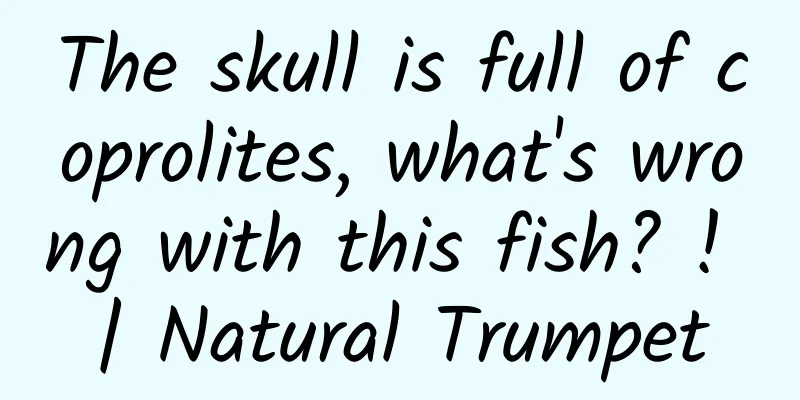The skull is full of coprolites, what's wrong with this fish? ! | Natural Trumpet

|
Welcome to the Nature Trumpet column, where we will introduce some of the latest and interesting natural research. This column will be updated every other week, so don't miss it if you pass by! In this episode, you will see: a house cat with a shrinking brain, a fish looking in the mirror, a fish fossil with a brain full of poop, "eating broadcast" from a penguin's perspective, and a hippopotamus that can recognize the voices of its own kind. Cats with shrinking brains Over the past 10,000 years, cats have been gradually domesticated by humans. As a result of becoming house cats, their brains have shrunk. Domestic Cat | Muhammad Mahdi Karim/Wikimedia Commons The researchers compared the skull sizes of domestic cats and their closest wild relatives, the African wildcat (Felis lybica) and the European wildcat (Felis silvestris). They found that the skulls of domestic cats were 25 percent smaller than those of the latter two species. In other words, domestic cats have much smaller brains than their wild ancestors. European wildcat (Felis silvestris) | Pasztilla aka Attila Terbócs / Wikimedia Commons Does this mean that your cat is definitely not as smart as a wild cat? Not necessarily. In the process of selecting and domesticating domestic cats, "gentleness" is one of the most important selection criteria - after all, who doesn't want a gentle and clingy pet! Researchers believe that people prioritize the gentleness of domestic cats, reducing the excitability and fear of domestic cats, which inadvertently changes the way their brains develop, causing changes in the shape and size of the brain. In fact, among the animals domesticated by humans, it is not only the domestic cats whose brains have become smaller. Sheep, rabbits, dogs and other animals have also undergone similar changes. Fish can recognize themselves in the mirror Fish may be smarter than we thought - they can recognise themselves in the mirror. The protagonists of this experiment are cleavers (Labroides dimidiatus). The researchers painted a brown mark on their throats and placed a mirror on one side of the tank. After seeing themselves in the mirror, 17 of the 18 cleavers participating in the experiment began to scrape their throats in an attempt to remove the mark - this shows that they have realized that the "fish" in the mirror is themselves and the mark is on their bodies. After seeing its reflection in the mirror, the wrasse began to scratch the brown mark on its throat. | Reference [2] Will the fish think that the person in the mirror is not themselves, but one of their own kind? Researchers have found that animals often behave aggressively when they encounter one of their own kind, and the cleaverfish is no exception. In this test, the fish did not attack themselves in the mirror, which also shows that they did not mistake their own reflection for one of their own kind. The cleaver fish looks in the mirror | References [2] Why choose brown markings? The researchers believe that brown markings look like small parasites, which are a major food source for wrasses, and are something they would pay attention to in their natural environment. They think that some previous mirror tests may have failed because the markings made at the time would not attract the attention of the animals; that is, they may recognize that it is themselves in the mirror, but think that having a mark on their body is not a big deal. The mirror test is often used to determine whether animals have self-awareness, but it is still controversial. For example, it is less reproducible in research and is limited to animals that rely on vision, which may be the reason why animals that rely mainly on smell (such as cats and dogs) cannot pass it. Fish fossil with a brain full of shit In Maryland, USA, people found a special fish skull fossil: its brain is full of shit... Fish skull filled with coprolites | the Calvert Marine Museum This fish, which is the most miserable dead fish, is Astroscopus countermani, a stargazer, which lived 9 million years ago and is now extinct. Its skull, about 5 cm wide, is filled with hundreds of tiny particles. Based on the size, shape and rich calcium and phosphate characteristics of the particles, scientists believe that these particles are coprolites. This fish usually lived on the seafloor | Apokryltaros They speculate that after the fish died, some scavengers (probably worms) drilled into its skull and had a feast; but at the same time, these diners also used the restaurant as a toilet, leaving behind a lot of excrement about 2.5 mm in length. Millions of years later, the excrement became coprolites and filled the fish skull, making this fish the first known fish with a brain full of feces in the paleontological world, and it has since gone down in history. Penguin's perspective on eating On "Penguin Awareness Day" on January 20, the Wildlife Conservation Society released an interesting video: following penguins fishing from the perspective of the first penguin. In the waters off Argentina, researchers put a waterproof camera on a male Papua penguin (Pygoscelis papua). The PenguinCam followed the penguin as it dove into a school of sardines, encountered other penguins fishing, and albatrosses and cormorants above; of course, the camera also recorded the moment when the penguin successfully caught food. After the penguin completed this foraging trip, the researchers removed the camera and secretly observed whether it was affected. Fortunately, the protagonist returned to the nest and took care of the cubs as usual. Gentoo penguins can grow up to 90 centimeters in length, second only to emperor penguins and king penguins. They usually forage near the seabed, and researchers previously thought they would also prey on schools of fish near the surface. This time, the video provides conclusive evidence that penguins will not miss the opportunity to eat. Hippos can recognize the voices of their own kind Hippos can recognize the sounds of their own kind, and their attitude towards these sounds depends on how familiar they are with the other person. Hippos always make a wheezing sound | Nicolas Mathevon In the Maputo Special Reserve in Mozambique, there are many hippos living in the lake. Researchers recorded the calls of hippos from different groups and played them to them. Hippos will have different reactions to "acquaintances" living in the same group, "neighbors" in the same lake but from different groups, and "strangers" who are not in the same lake. If the sound comes from a familiar hippo, they will take the initiative to approach. However, if the sound comes from a strange hippo that has never been seen before, they will spray feces-this is a territorial marking behavior, which means "This is my territory, don't even think about coming over!". In this documentary, the filmmaker uses a man-made hippopotamus "detective" to take us closer to the private lives of hippos | Spy in the Wild / BBC Earth Normally, hippos seem inactive and indifferent to their surroundings when they stay in the water. But when researchers played the sounds of their own kind, they responded very quickly - it seems that they have been secretly paying attention to the slightest movement around them. Researchers believe that if a group of hippos needs to be relocated to another habitat for population protection, the staff can first record the sounds of the hippos and play them to the "indigenous people" there through a loudspeaker. "Hear the sounds before seeing the people" so that the indigenous people can get familiar with the calls of the new hippos first, and when they really meet, they will not fight each other. References [1]Cranial volume and palate length of cats, Felis spp., under domestication, hybridization and in wild populations | Royal Society Open Science (royalsocietypublishing.org) [2]If a fish can pass the mark test, what are the implications for consciousness and self-awareness testing in animals? (plos.org) [3]https://riviste.unimi.it/index.php/RIPS/article/view/17064 [4]https://newsroom.wcs.org/News-Releases/articleType/ArticleView/articleId/17134/Penguin-Takes-Astounding-Selfie-Video-of-its-Diving-and-Feeding-Activity-English-and-Spanish.aspx [5]Voice-mediated interactions in a megaherbivore: Current Biology (cell.com) Author: White Stork on the Shore, Mai Mai Editor: Mai Mai, Window Knocking Rain This article comes from the Species Calendar, welcome to forward If you need to reprint, please contact [email protected] |
<<: Why are most street lights yellow? The truth is not so simple...
>>: The third AIDS patient was "cured"! Can humans finally conquer AIDS?
Recommend
Suddenly your temper becomes bad and you suffer from insomnia? I suggest you check this part immediately
If you suddenly find yourself The weight that has...
How should young people prevent cancer?
In recent years, the incidence of cancer has beco...
Today is the end of the dog days. All four seasons are pleasant, but the best is the new autumn.
There is no heat through the east window at night...
Sony Mobile China is caught in a layoff storm: business is not good and employees are anxious
The rapid rise of Chinese mobile phone manufactur...
Douyin series "Peking University Huahua, Tsinghua University and Peking University Academic Masters' Learning Power"
Douyin series "Peking University Huahua, Tsi...
Tencent Micro Game Console Review: More Suitable for Heavy Mobile Game Players
Since the ban on game consoles was lifted, the ga...
Observation on buying traffic on Tik Tok and Kuaishou platforms!
As the current leaders of short video platforms, ...
30 high-quality information flow cases from 18 industries, check them out all at once!
This article shares with you 30 high-quality case...
Shen Yifan shows you how to use mind mapping to develop your strongest brain
Yifan will help you master mind mapping and devel...
Why do we need to clean the railway switches during heavy snow?
recently Northeast China hit by extreme cold wave...
Autonomous driving is just a story for Didi, not reality
Didi’s “big transportation” story may have been t...
"Andy Lau has thawed 95%!" Why has "Gong Xi Fa Cai" become a popular song for the Chinese New Year?
Every time I hear the prelude of "Gong Xi Fa...
What are the functions of the Lanzhou mother and baby WeChat applet? How much does it cost to develop a WeChat mini program?
As a typical representative of the market segment...
How to earn income through Baijiahao self-media, Baijiahao operation skills!
It is well known to all self-media people that Ba...









